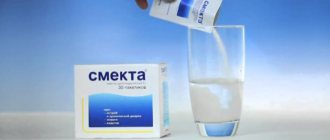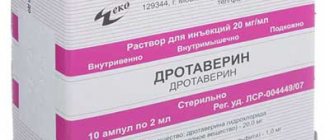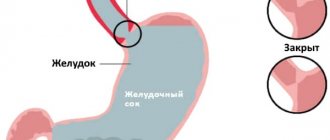Medicinal properties
According to the pharmacotherapeutic classification, the drug is intended for the treatment of infectious and inflammatory diseases of the digestive tract. Diosmectite is a silicate of magnesium and aluminum that exhibit enveloping properties.
Penetrating into the stomach and intestines, Smecta binds to the glycoproteins of the mucous membranes, which determines its effect:
- enveloping;
- antimicrobial;
- antidiarrheal;
- anti-inflammatory.
It is important to remember that Smecta does not eliminate germs and infections that have entered the digestive tract . It helps the epithelial lining of the stomach perform a protective function and prevents pathogenic microflora from adversely affecting the condition of internal organs.
When using the drug, there is no staining of stool in unusual colors. In therapeutic dosages, the drug also does not affect the time during which food masses pass through the intestines.
During studies of the effectiveness of Smecta with the participation of six hundred patients, a significant decrease in the frequency of bowel movements was noted during the first three days of use. Effectiveness for diarrhea is enhanced when combined with oral rehydration solutions.
Smecta is not absorbed into the systemic circulation from the stomach and intestines, and also does not undergo metabolic transformations in the liver and kidneys, like other drugs. That is why the drug has a high safety profile - you can give Smecta to a child with vomiting for indications from one month.
pharmachologic effect
Antidiarrheal drug, is an aluminosilicate of natural origin. Has an adsorbing effect.
Stabilizes the mucous barrier of the gastrointestinal tract, forms polyvalent bonds with mucus glycoproteins, increases the amount of mucus and improves its cytoprotective properties (with respect to the negative effects of hydrogen ions of hydrochloric acid, bile salts, microorganisms and their toxins).
It has selective sorption properties, which are explained by its discoid-crystalline structure; adsorbs bacteria and viruses located in the lumen of the gastrointestinal tract.
Smecta in therapeutic doses does not affect intestinal motility.
Diosmectite is radiolucent and does not stain stool.
Aluminum in the composition of diosmectite is not absorbed from the gastrointestinal tract, incl. for gastrointestinal diseases accompanied by symptoms of colitis and colonopathy.
Smecta is not absorbed. It is excreted from the body unchanged.
Causes of vomiting
The effectiveness of Smecta for nausea and vomiting depends on the reasons that provoked the pathological condition.
Nausea and vomiting can be caused by the following factors:
- indigestion;
- eating unusual foods or dishes;
- proliferation of pathogenic bacteria;
- infectious infection of the digestive tract;
- binge eating;
- sharply decreased or increased acidity of gastric juice;
- use of antibiotics for a long time or in high dosages;
- food poisoning.
In addition, vomiting accompanies diseases of the pancreas, high blood pressure, motion sickness, and organic pathologies of the digestive tract.
To determine the cause of vomiting, especially if it appears frequently over several days, you should consult a doctor - a therapist or gastroenterologist for adults, a pediatrician for children. In case of excessive vomiting, it is important to prevent dehydration of the body until qualified medical care is received, since a large amount of water is removed from the body with vomit.
Use of smecta for constipation
On the Internet you can often find information like: “If your child has diarrhea, give him Smecta”, “Smecta holds the intestinal contents together and stops diarrhea.”
It seems that everything is clear - Smecta helps with frequent and weak stools. But the doctor unexpectedly prescribes this drug for constipation.
And constipation after Smecta, if you look at the instructions for use, is one of the side effects. Was the doctor mistaken?
How does the drug work?
Diosmectite, from which Smecta is made, belongs to adsorbents - substances that absorb liquid and gaseous chemical elements. This particular adsorbent for the gastrointestinal tract is useful for 4 properties: mucosal stabilization, selective absorption, fluidity, safety.
- Stabilization of the mucous membrane is achieved through a physical barrier. A thin film envelops the digestive organs from the inside and prevents damage. Bacteria, salts, viruses, acid and toxins do not reach the walls of the stomach or intestines, and the chances of developing or developing gastrointestinal disorders are reduced.
- Selective absorption of trace elements means that Smecta absorbs only unwanted chemicals. Beneficial salts, minerals and vitamins will remain in place, while destructive materials will leave the body naturally.
- The high fluidity of the drug leads to the fact that diosmectite quickly spreads throughout the digestive organs after administration and begins to act, if not instantly, then very quickly.
- The safety of the drug is due to its natural origin (the reagent is obtained from white clay). Smecta does not enter the bloodstream and is completely eliminated from the body along with toxins.
In short, Smecta works in the following way for constipation: it enters the stomach, quickly spreads throughout the gastrointestinal tract, creates a film that prevents the absorption of harmful substances, adsorbs (absorbs) everything unnecessary and leaves the body with this excess.
So how does the drug help with constipation?
Smecta is not a “fastening” drug; such a concept does not exist in medicine. It physically removes all waste, toxins and pathogenic microorganisms that can cause diarrhea, constipation or other gastrointestinal disorders. It is prescribed in the following cases:
- infections in the intestines;
- food poisoning;
- intoxication due to colds;
- formation of pathogenic flora (dysbacteriosis);
- consequences of poor nutrition;
- excessive gas formation;
- diarrhea and constipation of various origins.
Constipation, for which Smecta is prescribed, can occur due to poor nutrition, long-term use of certain medications, or allergies. In all these cases, the medicine will restore the process of defecation and bring the digestive system back to normal.
For both children and adults
This medicine can be prescribed at any age. Due to the fact that Smecta is not absorbed, it can even be given to infants.
It is often prescribed for children under one year of age for both therapeutic and preventive purposes. In the first year of life, intestinal flora is formed in children, and this process is accompanied by frequent colic, diarrhea, vomiting, and intoxication.
In the stomach of a newborn, there is a real war between the fragile immune system and bad bacteria, and a common result of this process is constipation in the child. Smecta can handle this.
In addition, constipation is accompanied by pain in the child and sleepless nights in the parents, and in this matter the drug saves the nerves of all participants.
Will Smecta help with nausea and vomiting?
Smecta helps with vomiting symptomatically - this means that the medicine can eliminate nausea, vomiting and abdominal discomfort as symptoms. But if these are symptoms of more serious pathologies, Smecta will not eliminate the cause, but will only mask the condition by coping with its manifestations.

Smecta for nausea and vomiting will be effective in cases where these conditions are caused by:
- imbalance of microflora with a predominance of pathogenic bacteria;
- taking medications that destroy microflora - antibiotics;
- fermentation processes due to indigestion or consumption of unusual dishes and products;
- food poisoning.
The severity of the disease determines the use of Smecta as monotherapy or its addition to other medications as part of a combination treatment.
Contraindications and side effects
Smecta is not recommended for use if you have the following diseases and problems with the body:
- insufficient levels of sucrase and/or isomaltase enzymes;
- individual fructose intolerance;
- problems with intestinal patency;
- glucose-galactose malabsorption syndrome;
- hypersensitivity, individual intolerance to the medication and the ingredients present in its composition.
If the patient suffers from a history of severe chronic constipation, then he should use Smecta with great caution. It is recommended to do this under the supervision of your attending physician.
The most common side effects caused by Smecta include:
- mild constipation;
- rash;
- itching;
- hives;
- angioedema.
Most of these side effects are caused by overdosing the drug or using it too often. After bringing the medication regimen in accordance with the instructions for use, all negative effects most often stop. If this does not happen, you need to stop using the medication and, if possible, visit your doctor.

Taking Smecta may have side effects
When Smecta is ineffective
Smecta is most effective for nausea and vomiting if these phenomena are caused by external factors, for example, a single intake of unusual food or a temporary imbalance in the balance of beneficial and pathogenic intestinal bacteria.
If the cause of the disorder is organic and functional diseases of the gastrointestinal tract, Smecta will be effective only in combination with treatment aimed at eliminating the causes. In these cases, Smecta acts as a supportive, symptomatic drug.
Smecta for constipation: dosage, instructions for use, indications and contraindications
Good afternoon, many will be interested in understanding their health and their loved ones, and I will tell you my experience, and we will talk about Smecta for constipation: dosage, instructions for use, indications and contraindications. Most likely, some details may differ, as was the case with you.
Please note that you should always consult with highly specialized specialists and not self-medicate. Naturally, you can quickly find the answer to the simplest questions and diagnose yourself.
Write your questions/suggestions in the comments, and together we will improve and supplement the quality of the material provided.
Pharmacotherapeutic group
Antidiarrheal drugs. Other intestinal adsorbents. Diosmectite
Directions for use and doses
up to 1 year: 2 sachets per day for 3 days, then 1 sachet per day;
over 1 year: 4 sachets per day for 3 days, then 2 sachets per day.
On average 3 sachets per day.
In practice, at the beginning of the course of treatment (during the first 3 days), the daily dose can be doubled.
Up to 1 year: 1 sachet per day
From 1 year to 2 years: 1-2 sachets per day
Over 2 years: 2-3 sachets per day
On average 3 sachets per day.
The preferred time of administration is between meals, for esophagitis - after meals.
Recommended course of treatment: 3-7 days.
In adults, rehydration is not necessary except in special cases.
How to take Smecta?
If the child is not an infant, then the total daily dosage of Smecta should be divided into 2 - 3 doses. For example, if the doctor has prescribed you to take 6 sachets per day, then it is optimal to drink the drug three times a day, two sachets. Accordingly, at a dosage of 2 or 3 sachets per day, it is recommended to take the drug one sachet 2 or 3 times a day.
If one sachet per day is prescribed, then it is taken at a time at any time of the day. In this case, it is recommended to dilute the required number of Smecta sachets in water each time immediately before taking, and not in advance.
That is, when taking one sachet three times a day, each time the contents of one sachet should be diluted in half a glass of water immediately before use.
For infants under one year old, the entire daily dosage of Smecta is immediately mixed in a small amount of a semi-liquid or liquid product and given several times a day.
It is optimal for the baby to drink the product with Smecta in three doses in approximately equal portions.
But in practice this is not always achievable, so you can give the drug more than three times a day, making sure that the child drinks or eats the entire diluted dosage of Smecta during the day.
The duration of treatment for various conditions with Smecta ranges from 3 to 7 days, and is determined by the rate of improvement and disappearance of painful symptoms. If the drug is taken for acute diarrhea, the minimum acceptable course of therapy is three days.
This means that you must take Smecta for three days, even if the diarrhea stopped earlier. If there is no improvement in your condition within a week of starting to take Smecta, you should stop using the drug and consult a doctor.
You should also consult a doctor if you experience abdominal pain or fever.
In case of acute diarrhea, in addition to taking Smecta, it is imperative to replenish fluid losses in the body, that is, carry out rehydration therapy. This is especially important for infants under one year of age.
Rehydration therapy consists of drinking a special solution (Regidron, Trisol, Disol, Gidrovit, Reosolan, Citraglucosolan, etc.), tea, compote, mineral water, fruit drink or any other liquid in the amount of 0.5 liters for each episode of loose stool.
You should drink the liquid in small sips so as not to provoke vomiting.
People suffering from chronic constipation should take Smecta with caution, limiting the course of its use to the minimum effective period. That is, it is necessary to stop taking the powder as soon as the symptoms for which the use of Smecta was started disappear. For example, if the symptoms go away after 2 days, then you should not take the drug for longer.
Side effects and contraindications for use
side effects in people of any age and gender:
:
- Constipation;
- Bloating;
- Vomit;
- Allergic reactions (urticaria, rash, skin itching, Quincke's edema).
Constipation and bloating usually go away quickly on their own after stopping the use of Smecta or after reducing the dosage.
The use of Smecta powder is contraindicated
if a person has the following diseases or conditions:
- Intestinal obstruction;
- Fructose intolerance;
- Glucose-galactose malabsorption syndrome;
- Sucrase-isomaltase deficiency;
- Individual hypersensitivity to the components of the drug.
Interaction with other drugs
When taken orally, Smecta is not absorbed (even in severe intestinal diseases) and is completely eliminated from the body, without turning the stool any color.
Interaction
The drug may reduce the rate and degree of absorption of simultaneously taken drugs. It is not recommended to take Smecta ® simultaneously with other drugs.
Active substance:
- 3D images
- Compound
- pharmachologic effect
- Pharmacodynamics
- Pharmacokinetics
- Indications for the drug Smecta
- Contraindications
- Use during pregnancy and breastfeeding
- Side effects
- Interaction
- Directions for use and doses
- Overdose
- special instructions
- Release form
- Manufacturer
- Conditions for dispensing from pharmacies
- Storage conditions for the drug Smecta
- Shelf life of the drug Smecta
- Prices in pharmacies
- Reviews
Indications of the drug Smecta ®
For adults and children (including infants):
acute and chronic diarrhea (allergic, drug origin; violation of diet and quality food composition), diarrhea of infectious origin (as part of complex therapy);
Yes, thanks for the information. Yes, but I will consult with a specialist.
symptomatic treatment of heartburn, bloating, abdominal discomfort and other symptoms of dyspepsia accompanying diseases of the gastrointestinal tract.
Drug overdose
In accordance with the instructions for use of Smecta, taking increased doses of the drug is fraught with the appearance of prolonged constipation. Due to difficulty in defecation, bezoar stones (dense lumps of plant fibers) can form in the body. This situation is unsafe and requires immediate examination by a specialist.
Contraindications and side effects
Despite the safety of the composition and effective therapeutic effect on the body, the drug has contraindications. Situations arise in which its use is undesirable or even detrimental to health:
- in case of diagnosing intestinal obstruction (due to adhesions, tumors, hernia, stones, the presence of foreign bodies);
- with fructose intolerance, impaired absorption of glucose/galactose, deficiency of sucrose/isomaltose enzymes.
According to Smecta's instructions, taking it in such conditions can weaken intestinal motor activity and can cause constipation. People suffering from chronic constipation should take the suspension with caution. In such cases, it is prescribed in combination with drugs that maintain water balance in the body.
If you already have allergies to artificial flavors or any of the components of the drug, you should stop taking it. After carefully studying the composition of the drug “Smecta”, it is necessary to consult a specialist so as not to aggravate the condition. A replacement suspension can only be prescribed by the attending physician after analyzing a number of laboratory samples.
Among the undesirable manifestations of using the drug, mild constipation, allergic skin rashes, itching and swelling in these areas may occur. As a rule, they disappear when the dosage of Smecta is reduced. The decision to change the dosage regimen should be made together with your doctor.
Some patients noted bloating and frequent bowel movements, darkening of tooth enamel, pain and heaviness in the gastrointestinal tract as side effects. These are isolated manifestations that disappear with discontinuation (replacement) of the drug.
Instructions for use in adults and children
The dosage of Smecta is determined by the doctor. It focuses on the patient’s age, general health, and severity of diarrhea. Being a natural enterosorbent, the drug is indicated for use by patients of any age, including babies from 4 months from birth.
When using a ready-made suspension, the sachet must be kneaded with your fingers until smooth. Then all that remains is to open the package and pour the contents into your mouth.
The procedure for making a suspension from powders is somewhat different. The suspension for oral administration should be prepared immediately before use.
Smecta dosage for adults is 1 sachet of powder per 100 ml of boiled water cooled to room temperature. The mass is brought to a homogeneous consistency without lumps or clots. Drink within 5-10 minutes after preparation.
It is allowed to divide the portion into 2-3 doses and store during the day at room temperature away from sunlight.
The maximum dose for adult patients is 6 packets per day for 3-7 days, depending on the degree of damage.
In complex cases of diarrhea and the threat of dehydration, the instructions for use of Smecta recommend taking the drug for at least 3 days in a row. Treatment for more than a week is not advisable.
If after this period the alarming symptoms have not disappeared, an examination and clarification of the diagnosis is necessary.
The drug begins its therapeutic effect after using the first package. The effect is felt after 2-3 hours, with diarrhea - within 6-12 hours. In case of inflammation of the esophagus (esophagitis), relief occurs within 30 minutes. When treating with the drug, it is necessary to follow a gentle diet and optimal drinking regimen.
The Smecta instructions for children define the main indications and permissible portions of the medication. To prepare a medicinal mixture for infants up to one year old, the daily dose of the drug is diluted in 50 ml of liquid nutrition (in milk, puree, mixture). The resulting suspension must be given to the baby, divided into several portions.
Children aged 3 years can drink 200-300 ml (2-3 packets) per day, from 5 to 12 years old can take 3-4 packets per day (up to 300-400 ml of the diluted mixture).
The time for taking Smecta depends on the patient’s diagnosis:
- For inflammation of the esophagus (esophagitis), the suspension is used immediately after eating.
- In other indications for the use of Smecta, it is consumed either 1 hour before meals or 2 hours after.
For infants, the medicine is given with food or drinks or between feedings. The second option is preferable, since diosmectite is able to bind and remove from the baby’s body all the useful elements that it receives from food. For older children - in 2-3 doses during the day in accordance with the recommendations.
As practice shows, children enjoy drinking the flavored mixture. They especially like the vanilla flavor of the suspension. It is recommended to first offer the child to drink a small part of the diluted suspension so as not to trigger a gag reflex. If everything went well, finish the prepared portion in small sips.
Abdominal pain can be caused by a variety of reasons. Poor quality food, irregular eating habits, or even stress can be to blame.
In such a state, you want only one thing: to relieve pain, stop diarrhea and calm the gastrointestinal channels.
One of the most popular drugs indicated for use both for adult patients and for children of different ages is Smecta.
When using a ready-made suspension, the sachet must be kneaded with your fingers until smooth. Then all that remains is to open the package and pour the contents into your mouth.
Dosage schedule
Dosage and frequency of administration vary for different age groups.
The following are standard dosage regimens that can be adjusted by your attending physician:
- for a child from one month to a year – 3 g of diosmectite per day;
- for a child from one to two years old – up to 6 g per day;
- from two years – 6-9 years.
If an adult is vomiting, take Smecta 9 g of the active substance. Take the medicine between meals; it is advisable that the interval after meals and before the next meal be the same.
Smecta after vomiting in a child is taken with rehydration solutions or large amounts of water to prevent dehydration. If symptoms do not resolve within two days, you should stop taking it and seek medical advice.
Preparation of the suspension
For adults, the contents of the sachet should be diluted in 100 ml of water, mixing thoroughly. The suspension must be prepared immediately before taking the medicine; the prepared suspension cannot be stored.
For a child over one month old, the contents of the sachet are diluted in 50 ml of water and given in small portions throughout the day. Dilution in semi-liquid food is allowed: broth, juice, baby food, puree.
Powder dosage
Smecta must be taken according to a certain scheme. It is recommended to properly dilute the powder first. For infants, one sachet is diluted in 50 ml of warm water or mixture, porridge, puree.
The powder is poured in gradually, and you need to mix it evenly to get a homogeneous liquid or puree.
If the baby is not able to drink the entire volume of the prepared solution, then the powder can be dissolved in a smaller amount of water. Otherwise, Smecta is taken several times.
Pediatricians advise diluting the powder immediately before taking it. Do not store the prepared solution in a bottle for several hours.
If the baby does not like the smell or taste of the composition, Smecta is replaced with a milder similar drug - Neosmectin.
For older children, the powder is dissolved in ½ glass of warm water, while the powder is gradually added and thoroughly mixed.
The drug is indicated for use three times a day in a dosage taking into account the severity of diarrhea. More often, the course of treatment does not exceed 3 days. In severe cases, treatment lasts a week.
Since the product in question is an enterosorbent, its optimal effect is observed when consumed between meals.
If diarrhea is accompanied by heartburn, then Smecta is drunk after eating.
Scientists have proven that dosage and long-term therapy do not depend on the age and weight of the child, but on the intensity of intoxication, severity of infection, poisoning, allergies, varying:
- up to 2 sachets per dose;
- 1-6 sachets per day.
Since the powder in question is characterized by an adsorption effect, it is therefore not taken with other drugs so as not to reduce the absorption of the drug.
If acute diarrhea is detected, infants under one year of age are recommended to drink 2 sachets per day for 3 days. Then drink 1 sachet per day.
Children over one year of age are prescribed a three-day course of treatment, 4 sachets per day. Then it is recommended to drink 2 sachets per day. Adolescents and adults are prescribed up to 6 sachets per day.
For other pathologies, infants up to one year of age are prescribed 1 sachet per day. Children aged 1-2 years are recommended to drink up to 2 sachets of Smecta per day. Children over 2 years old are prescribed up to 3 sachets per day.
Undesirable effects

Adverse reactions were mainly noted from the digestive system. Constipation most often develops, but it does not require additional therapy and disappears after reducing the dosage. In some patients, severe constipation may require discontinuation of Smecta therapy.
Less common symptoms were bloating, flatulence, and increased vomiting or diarrhea. Allergic reactions to the drug are accompanied by skin rash, hives, and itching. In some patients, a severe allergic reaction caused angioedema. An allergy is an indication for immediate discontinuation of taking Smecta.
Smecta for constipation in adults and children
The medicine is used to treat heartburn, constipation of various origins, bloating, and colic in babies. The composition of the drug includes components that adsorb and envelop the gastric mucosa and help cleanse the intestines.
Smecta for constipation is prescribed for the following pathologies:
- intestinal infections;
- dysbacteriosis;
- food poisoning;
- constipation of allergic etiology;
- disruptions in the functioning of the intestines caused by flu or colds;
- constipation caused by changes in diet and taking certain medications.
When using Smecta solution for constipation in infants, it was noticed that the medicine effectively eliminates problems associated with flatulence and intestinal colic. The drug is prescribed for constipation caused by dysfunction of the digestive system and intestines, as well as duodenitis, gastritis and other gastrointestinal pathologies.
How does the sorbent work?
The active substance of the drug, diosmectite, is an adsorbent that absorbs gaseous and liquid elements. This component is effective with several properties that have a beneficial effect on humans: mucosal stabilization, fluidity, selective absorption and safety.
- Stabilization of the intestinal mucosa is achieved through the formation of a physical barrier. A thin film carefully envelops the digestive organs, preventing them from being damaged. Bacteria and toxins cannot enter the mucous walls of the stomach or intestines, reducing the development of gastrointestinal disorders.
- The high fluidity of the drug contributes to the rapid spread of diosmectite throughout the digestive organs and begins to act very quickly.
- Selective absorption of trace elements indicates that the drug absorbs only unwanted chemicals. Minerals, beneficial salts and vitamins remain in the intestines, and destructive substances are removed from the body during the act of defecation.
- The safety of the drug is due to its composition (the reagent is obtained from natural white clay). The medicine does not enter the bloodstream and is excreted from the body with toxins.
The drug helps with constipation
Smecta solution is not a drug that “fastens”; there is no such concept in medicine. It cleanses the intestines of waste, toxins and microorganisms that cause constipation, diarrhea or other intestinal disorders.
The drug is also indicated for the following pathologies:
- food poisoning;
- formation of pathogenic flora (dysbacteriosis);
- diarrhea and constipation of various origins;
- infections in the intestines;
- excessive gas formation;
- intoxication due to various colds;
- consequences of poor nutrition.
You may also need to take Smecta due to allergies and long-term use of certain medications. In all of the above cases, the drug will quickly restore bowel movements and bring the gastrointestinal tract back to normal.
Features of using Smecta for constipation
Smecta solution is intended for oral use and is presented in the pharmacy chain in powder form. Before use, you need to dissolve the powder in water (100 ml), stirring until a homogeneous consistency.
Take one hour before meals 2-3 times a day. It is possible to use the solution after a meal, after 30-60 minutes, the main thing is that the food and the drug enter the body separately. This is due to the excretory properties of diosmectite, which, in addition to pathogenic microflora, also removes beneficial substances from the body.
The daily rate of sorbent completely depends on the age and condition of the patient. So, for adults it is 9 g, for children – 3 g. The use of this drug is possible from the first days after birth. The composition can be diluted in mixture or milk. The duration of treatment with the solution is no more than 7 days.
Problem with bowel movements after taking the drug
The instructions for use indicate that Smecta is an effective antidiarrheal agent. The medicine is usually well tolerated and does not interfere with bowel movements. The active substance diosmectite does not affect the transit time of food through the digestive tract and does not affect peristalsis, therefore Smecta, as a drug, does not cause constipation.
However, in rare cases, constipation is still observed after Smecta. According to the instructions, constipation from Smecta can occur in case of overdose. Most often, this effect occurs in children. In such a situation, doctors recommend not stopping treatment, but adjusting the dose of the drug. To solve the problem of constipation, you just need to dilute the powder in 200 ml of water or reduce its daily intake.
Features of reception for children
The drug is safe to treat children of any age. It effectively fights flatulence, intestinal colic, and cleanses the child's body of various toxins that accumulate during constipation. The medicine can be prescribed to newborn children.
The release form of Smecta powder is individual 3 g packets. For constipation in children, it is recommended to take Smecta according to the regimen specified in the instructions:
- for newborns and babies - 1 pack;
- children from 1 to 2 years old – 2 packs;
- children 3-6 years old – 2 or 3 packs;
- children over 6 years old – 3 packs.
Features of using the drug for infants
The powdered drug has a beneficial effect on the digestion of babies without disturbing the natural intestinal microflora.
Smecta also helps not only against constipation, but also against diarrhea. If a baby is often bothered by colic, the drug quickly improves its condition.
Smecta helps newborn babies in the following cases:
- with bloating;
- vomiting;
- colic;
- when constipation reappears due to intoxication of the body with decay products;
- changing your diet to avoid problems with bowel movements.
The sorbent works directly in all parts of the intestine and is excreted during bowel movements.
Sometimes, to eliminate constipation, doctors recommend giving the baby a cleansing enema, which is performed using Smecta solution. One sachet of solution is diluted in 100 ml of boiled water. The product must be well dissolved until a homogeneous consistency is obtained. This solution is introduced into the intestines using a microenema.
Side effects
If constipation occurs, the therapeutic effect of Smecta solution is achieved by removing pathogenic bacteria and toxins from the body that cause intestinal disorders. Smecta does not aggravate constipation, nor does it cause it.
In most cases, the treatment solution is tolerated without side effects. The product does not affect the digestion process and does not interfere with bowel movements.
Actions in case of overdose
If you take a dose of the solution that exceeds the norm, it can provoke constipation or an allergic reaction to the components of Smecta. If constipation occurs, soon after taking the medicine, a high concentration of the medicine is observed in the gastrointestinal tract. In this case, they continue to take it, reducing the dosage.
If your body temperature rises, skin rashes appear, or Quincke's edema occurs, it is recommended to stop taking the sorbent and immediately seek medical help. The specialist will prescribe a diagnosis and provide symptomatic treatment of allergies.
To avoid side effects, you must adhere to the dosage recommended by your doctor. When treating infants with an adsorbent solution, you need to carefully monitor their well-being. If constipation or other deterioration occurs, consult a pediatrician and adjust therapy.
Source: https://proktoinfo.ru/zapory/medicamenty/smekta-pri-zapore
Many people are sure that Smecta is intended only for the treatment of diarrhea, since the drug binds feces. But doctors often prescribe medication for constipation. Although the instructions for its use indicate constipation as one of the side effects. Is the doctor mistaken in this case? Does Smecta really help with constipation?
Characteristics and description of the drug
“Smecta” is an adsorbent that contains an active substance such as dioctahedral smectite - a mixture of magnesium and aluminum silicates processed in a special way. The substance has a crystalline structure, due to which it envelops all pathogenic bacteria, toxins and viruses and removes them from the gastrointestinal tract along with feces. The drug works especially well against rotavirus infection.
This medication is not a binder; it helps eliminate waste, toxins and pathogenic bacteria, which provoke the development of diarrhea and other gastrointestinal pathologies. Therefore, the answer to the question of whether Smecta can be used for constipation will be positive.
The drug is prescribed in the following cases:
- infectious process in the intestines;
- intoxication with food or alcohol;
- intoxication due to colds;
- dysbacteriosis;
- hangover syndrome;
- nausea and vomiting;
- pain in the stomach and intestines;
- intestinal colic;
- flatulence;
- diarrhea or constipation of various origins;
- consequences of poor diet.
The disease can appear due to poor nutrition, allergies, and the use of certain medications. Therefore, “Smecta” will help against constipation at any age, even for infants, the drug normalizes the process of bowel movements and the activity of the digestive system.
The drug is sold in the form of a powder for the preparation of a suspension, which is packaged in 3 gram sachets.
Action of the drug
Dioctahedral smectite is an adsorbent that absorbs chemical elements in a liquid or gaseous state. It stabilizes the gastrointestinal mucosa, preventing damage to the digestive organs.
Due to its property, pathogenic microbes and toxins do not reach the walls of organs, and the risk of developing pathologies is reduced.
In this case, the drug absorbs only those chemical elements whose presence in the human body is undesirable.
The active substance spreads throughout all digestive organs in a short time and begins to act. “Smecta” for constipation is a completely safe drug, so it can be used even from the first months of life. It is created from natural ingredients, does not penetrate the bloodstream and is completely eliminated along with harmful substances from the body.
In infancy, the medication helps eliminate problems with bowel movements without disturbing the intestinal microflora. When constipation occurs after Smecta, this indicates non-compliance with the doctor’s recommendations. The activity of the gastrointestinal tract is restored immediately after discontinuation of the drug.
The medication acts not only as a sorbent, but also provides a therapeutic effect when there is a lack of potassium, magnesium and sodium in the body, and normalizes water-salt balance.
Undoubtedly, if you have constipation, you can take Smecta. The drug is taken before meals, and if a person has heartburn, then after.
One sachet is poured into a glass, diluted halfway with warm water, stir well, then drink.
The dosage of Smecta for constipation in adults and adolescents is three sachets per day. If severe diarrhea occurs, take six sachets per day. The course of therapy in this case is three days, and then for another 2 days they take 3 sachets per day.
The drug slows down the absorption of alcohol. If you take it before drinking alcohol, intoxication will occur more slowly. To avoid developing a hangover, it is recommended to take the medicine after drinking alcohol.
It is recommended to consult a doctor before treatment, since not all types of constipation can be treated with this drug.
Instructions for children
The medicine is prepared for children as follows: the contents of the sachet are diluted in 50 milliliters of warm water. It is allowed to mix the powder with puree, milk, compote.
The treatment regimen for constipation with Smecta is as follows:
- Up to 1 year of age, take one sachet per day.
- From 1 to 2 years – two sachets per day.
- From 2 to 12 years – two or three sachets per day.
For diarrhea, you need to take the medicine according to a different regimen:
- Children under one year old - 2 packets per day for three days, then 1 packet for 2 days.
- From one year to 12 years - 4 sachets per day for three days, then take 2 sachets for another 2 days.
- From 12 years old you need to take 6 sachets per day for 3 days, then for another two days, three sachets per day.
Additionally, it is necessary to ensure plenty of fluids during therapy to prevent dehydration.
Limitations in use
The drug has some contraindications:
- High susceptibility to the components of the drug.
- Fructose intolerance.
- Intestinal obstruction.
- Severe chronic constipation.
- Intestinal tumors.
- Adhesive disease.
- Presence of gallstones.
It is not recommended to take other drugs at the same time, as their effectiveness will be reduced. If Smecta makes things even worse, constipation persists for four days, treatment with the drugs is stopped, in which case you need to consult a doctor to prescribe a different treatment regimen.
Development of adverse reactions
The drug is capable of reducing intestinal motility to some extent; if consumed in large quantities, constipation may occur or aggravate an existing problem. Therefore, it is necessary to follow all doctor’s prescriptions.
During pregnancy, Smecta should be used for constipation for no more than three days. If negative symptoms appear, you need to contact the clinic.
The drug does not affect the speed of psychomotor reactions. During treatment, you can operate a car or other machinery.
Exceeding permissible doses
When using the medication in large quantities, an allergic reaction or constipation develops. In this case, the dosage of the medicine needs to be reduced. For children, it is recommended to dilute the drug in more liquid, and for adults to drink not three, but 2 sachets per day.
If a severe allergy develops, drug treatment is stopped and symptomatic therapy is carried out.
Cost, acquisition and storage of the drug
You can purchase Smecta in almost any pharmacy in the country. It is available without a doctor's prescription. The cost of the medicine is about one hundred and fifty rubles per pack of ten sachets. A package of thirty sachets will cost about three hundred and twenty rubles.
Store the medication in a dry, dark place where the air temperature does not exceed twenty-five degrees. The shelf life is three years from the date of release of the medicine.
Analogs
If for some reason it is not possible to use Smecta for constipation, the doctor may prescribe another drug. Analogues of the drug include:
- "Neosmectin".
- "Diosmectin."
These drugs also contain dioctahedral smectite. There are also other sorbents, but not all of them are quite effective and selective in action. In any case, treatment should be prescribed by a doctor.
Doctors' recommendations
During therapy with this medication, it is recommended to adhere to several rules:
- Drink enough liquid.
- Normalize your diet.
- Avoid certain foods that may cause indigestion.
This will help eliminate the pathology in a short time.
Conclusion
"Smecta" is an effective and safe remedy for solving digestive problems. The drug eliminates negative symptoms, removes toxins and pathogenic microbes from the body along with feces.
It can be used by both adults and children. If the dosage and all doctor's prescriptions are followed correctly, the medicine does not cause side effects.
It is important to follow all doctor’s prescriptions and recommendations and not exceed the dosage of the drug.
Source: https://FB.ru/article/460573/smekta-pri-zapore-dozirovka-instruktsiya-po-primeneniyu-pokazaniya-i-protivopokazaniya
Features of treatment
The medicine should be taken with caution if there is a history of severe, prolonged constipation. Children with acute vomiting and diarrhea must be prescribed oral solutions to restore water and electrolyte balance. The volume of solution depends on the intensity of vomiting or diarrhea; rehydration can also be prescribed for adults.
Smecta helps with nausea if the following treatment rules are followed:
- taking sweet or salty liquids to restore water and electrolyte balance;
- maintaining a gentle diet;
- exclusion of fatty foods, raw fruits and vegetables, spices;
- exclusion of frozen foods and drinks;
- preference for low-fat, boiled and steamed dishes.
If Smecta has not shown effectiveness within a week, you should consult a doctor.
Use during pregnancy
Smecta is approved for use throughout
and is taken for the same indications as for children, non-pregnant women or men. Dosages of Smecta for pregnant women correspond to those for adults, that is, in case of acute diarrhea, in the first three days you should take 2 sachets 3 times a day, and then for another 2 - 4 days, reduce the dosage by half (that is, 1 sachet per 3 times a day). For all other indications, Smecta is taken 1 sachet 3 times a day for 3 to 7 days.











